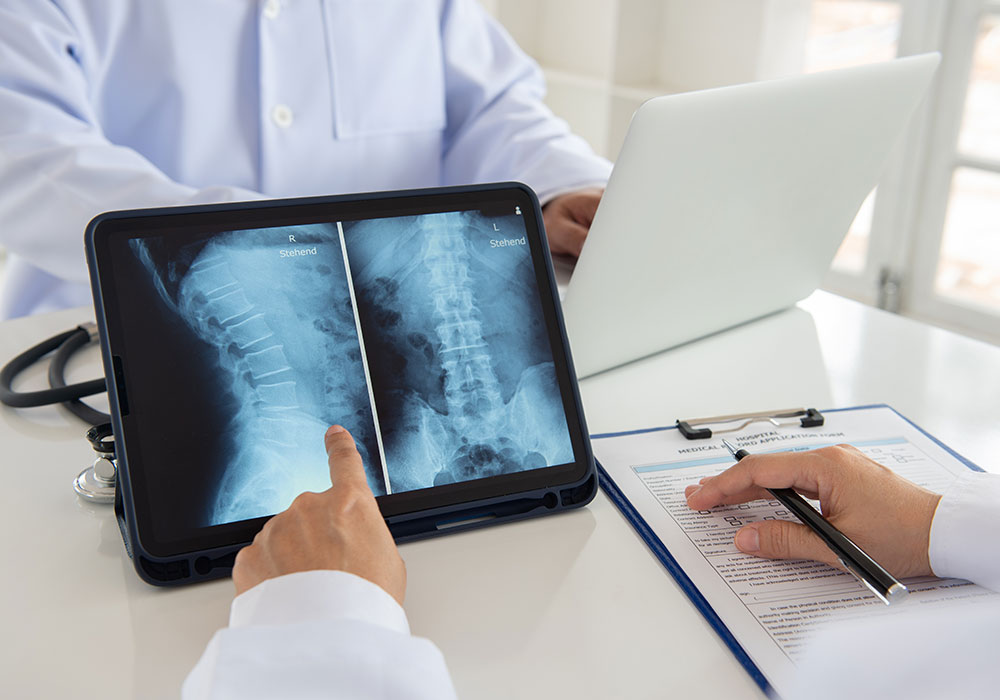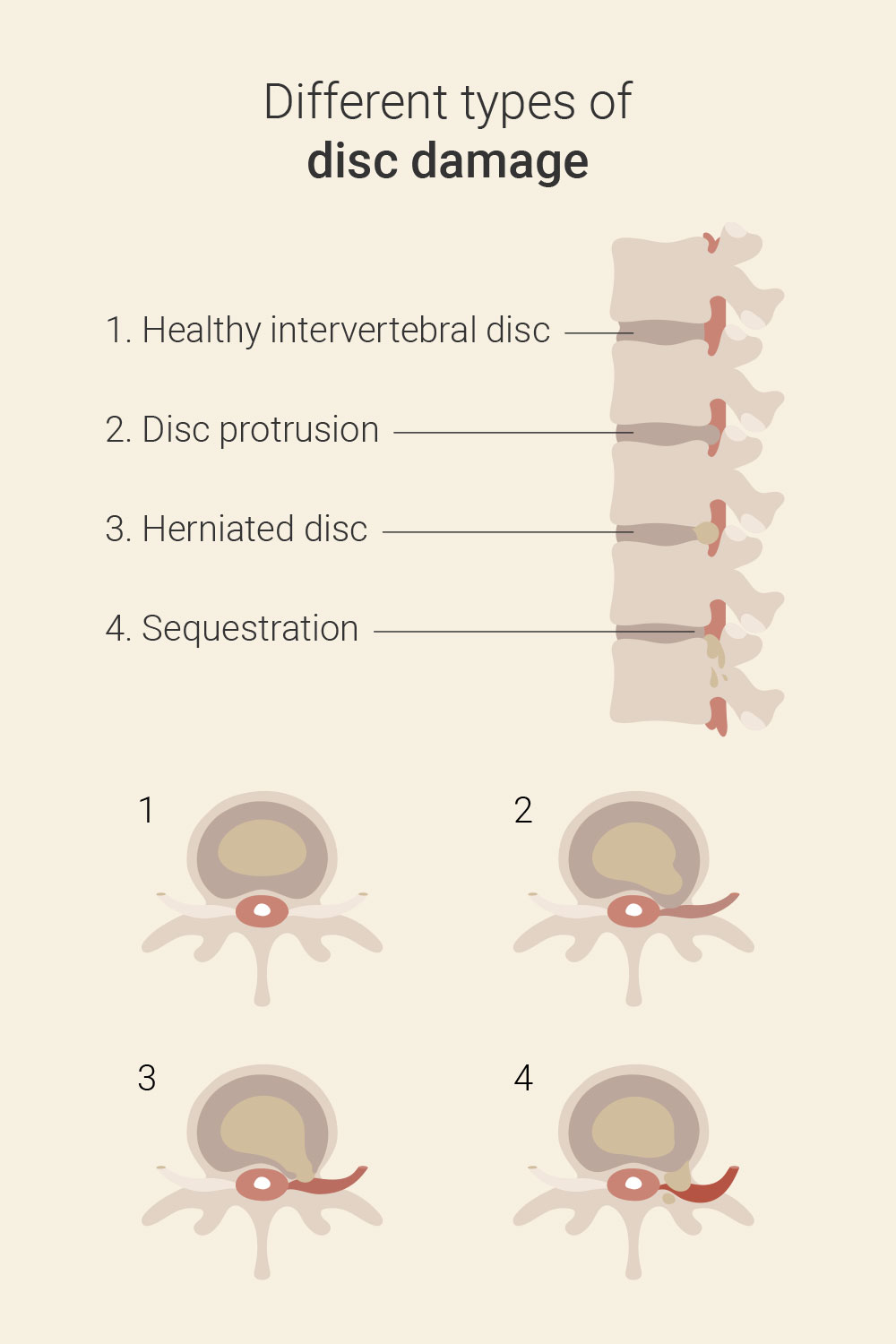Even the strongest of us can be confronted with back problems in the course of our lives. One possible and common cause of back pain is a bulging disc. This condition can significantly affect quality of life and make daily activities a challenge. In this article, we explain the difference between a disc prolapse and a disc protrusion. We will also show you how we can help you with this condition and treat bulging discs at our private practice for orthopaedics and traumatology in Frankfurt.

What are intervertebral discs?
Intervertebral discs are structured, cartilaginous “cushions” between the individual vertebrae in the spine. They are designed to support pressure and weight while allowing the spine to be flexible.
When you move, they are compressed and then stretched apart again, allowing you to move in different ways. The intervertebral discs also act as shock absorbers to absorb shocks and stresses placed on the spine.
Intervertebral discs are structured as follows:
Outer fibrous ring (annulus fibrosus)
The outer ring of the intervertebral disc consists of strong, fibrous tissue and surrounds the inner core. This ring serves to support the inner, softer substance and keep the disc stable.
Inner gel nucleus (nucleus pulposus)
The inner part of the intervertebral disc consists of a gel-like substance containing water and proteins. This nucleus is elastic and enables the intervertebral disc to deform and absorb loads when the spine moves.
What is a disc protrusion?
In a disc protrusion, part of the disc between the vertebrae in the spine pushes outwards. This occurs when the outer fibrous ring of the intervertebral disc is weakened or cracked and the inner gel core partially protrudes into the outer area of the intervertebral disc – but without breaking through the outer shell.
A bulging disc can cause pain and discomfort as the protruding part of the disc can press on nearby nerve roots or other anatomical structures. Symptoms can vary from person to person and can cause pain, numbness, tingling or weakness in the affected areas of the body.
What are the causes of a disc protrusion?
A protrusion of the intervertebral disc can be caused by various factors and risk factors. Such a finding is often not attributable to a single cause. In many cases, there is also a combination of different factors.
Typical causes and risk factors include
Age
Over the years, the intervertebral discs undergo a natural process. They lose elasticity and become more susceptible to degeneration, which increases the risk of protrusion.
Stress and overload
Repetitive strain and overloading of the spine, particularly in occupations or activities that require heavy lifting, severe bending or twisting of the spine, can stress the discs.
Injuries
Acute injuries or trauma, such as falls, accidents or sports injuries, can damage the discs and trigger a protrusion.
Poor posture and body mechanics
Poor posture and inadequate body mechanics, e.g. when lifting, can also increase the strain on the intervertebral discs.
Being overweight
Obesity increases the strain on the spine and can also lead to a bulging disc.
Genetic predisposition
There is evidence that genetic factors may play a role in susceptibility to intervertebral disc disease. If you have a family history of disc problems, you may have an increased risk of developing the condition.
Smoking
This can reduce blood flow to the intervertebral discs and impair the supply of nutrients. This can result in disc problems.

Bulging and herniated discs: what’s the difference?
Bulging and herniated discs are two different conditions related to the discs in the spine. They differ mainly in terms of the severity and type of disc problem.
Bulging disc (disc protrusion)
In a disc protrusion, part of the disc pushes outwards, but without breaking through the outer sheath (the outer fibrous ring). A disc protrusion is often considered less severe than a herniated disc. Therefore, the symptoms are usually less pronounced.
Herniated disc (prolapsed disc)
In the case of a herniated disc, the inner gel nucleus of the disc breaks through the outer fibrous ring and enters the space outside the disc. There it presses on nearby nerve roots or the spinal cord. A herniated disc can cause more severe symptoms than a bulging disc. It can cause more severe pain, numbness, muscle weakness and in some cases even neurological impairment. You can find more information on prolapse in our separate blog post “Slipped disc treatment: these options are available”
A disc protrusion can also be a kind of precursor or forerunner of a herniated disc. If the strain on the disc continues or worsens, the outer fibrous ring can weaken further. As a result, there is a risk that the inner gel nucleus will eventually break through the outer sheath and enter the space outside the disc.
However, not every protrusion necessarily leads to a prolapse. Many people have a disc protrusion without ever developing a herniated disc.
How is a bulging disc diagnosed?
A bulging disc is usually diagnosed through a combination of medical history, physical and imaging examinations. Here are the steps we usually take in our practice in Frankfurt when diagnosing a bulging disc:
Medical history
First, we will ask you about your symptoms and medical history. It is important that you tell us about any pain, numbness, tingling or other complaints relating to your back or extremities.
Clinical examination
The next step is to carry out a physical examination to check the mobility of your spine, muscle strength, reflexes and sensitivity. This will allow us to determine if there are any signs of nerve compression.
Imaging examinations
X-rays of the spine help us to identify changes in the spine, such as osteoarthritis or vertebral fractures. Bulging discs themselves are not normally easy to see on X-rays, as they consist mainly of soft tissue. We therefore use additional radiological procedures in this case. MRI is the most commonly used imaging technique for diagnosing bulging discs. It allows a detailed visualization of the discs and their surroundings. A CT scan can be used to provide additional information about the discs and their effects on the surrounding structures. This is particularly useful when an MRI is not possible or additional information is required.
How can a bulging disc be treated?
The treatment of a bulging disc depends on the severity of your symptoms, the degree of the bulge and your individual needs. In most cases, treatment begins conservatively with the following measures:
Pain management
We will prescribe painkillers and/or muscle relaxants. These medications can help with muscle tension and spasms caused by the bulging disc.
Injections
Depending on your individual findings, we can also administer epidural steroid injections into the area around your affected disc. Bulging discs can lead to inflammation in the area of the affected disc. Inflammation can cause pain and press on nearby nerve structures. The injected steroids are anti-inflammatory drugs that can reduce the inflammatory reaction in the area of the spine. This can also reduce the intensity of the pain. Less pain and inflammation can increase the mobility of the spine and allow you to perform everyday activities better.
Physiotherapy
Targeted physiotherapy can be helpful in strengthening the back muscles, stabilizing the spine and promoting correct posture. Physiotherapists can show you techniques to relieve pain and improve mobility.
Heat or cold applications
You can also use heat or cold applications to combat the symptoms. Some people prefer heat, while others benefit from cold. It is important to choose the method that is best suited to the individual’s discomfort.
Ergonomic adjustments
Changing workplace conditions (such as your desk chair and monitor height), for example, can also help to promote better posture and avoid unnecessary strain.
Weight management
If obesity is a contributing factor to bulging discs, weight loss is recommended. This will reduce the strain on your spine.
Treating a bulging disc: Further supportive therapy options in our practice in Frankfurt
Kinesio taping
This is a technique in which we apply special medical and elastic tapes to your skin. We use taping to treat various muscle and joint problems or to support their therapy. Kinesio taping can – in addition to conservative treatment – help to relieve pain and improve the stability of the surrounding muscles. The tapes lift your skin and promote blood circulation. They can relieve the muscles and spine and reduce the pressure on the diseased disc. This in turn can help the spine to improve functionality.
Acupuncture
In this alternative treatment method from Traditional Chinese Medicine (TCM), we place thin needles at specific points on your skin to relieve pain and promote overall health. Acupuncture can release endorphins. These are your body’s own pain-relieving substances. These help to reduce pain associated with bulging discs. The treatment also helps to relieve muscle tension. This can be beneficial for disc protrusions, which are often accompanied by tense muscles. The stimulation of acupuncture points can promote blood circulation and improve the supply of nutrients to the intervertebral disc.
Treating a bulging disc in Frankfurt
As you can see: There are various ways to treat a bulging disc. Usually, this does not require surgery. The combination of treatment options depends on your individual situation and your symptoms.
Our top priority is to develop an optimal conservative therapy strategy to minimize the pain and impairment caused by the disc protrusion as much as possible. Do not hesitate to contact us – we are your experts for spinal therapy in Frankfurt!
Image sources: 377073510 © utah51 | 433581203 © dbayan | stock.adobe.com